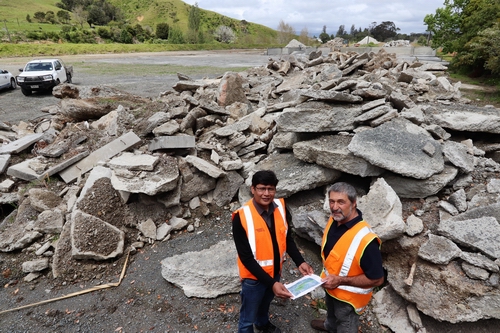Two contracts mark start of summer Awanui flood works
10 Dec 2018, 2:57 PM
Two recently-let contracts collectively worth roughly $500,000 effectively mark the start of summer works as part of a wider $15-million, several-year upgrade of the Awanui River flood scheme.
Te Hiku constituency representative Mike Finlayson says the Northland Regional Council (NRC) had formally awarded both contracts to local firm Kaitaia Contracting Limited earlier this month, on 04 December.
Work on both contracts would occur concurrently and while some initial ‘enabling works’ were being carried out in the lead-up to Christmas, work would begin in earnest in the New Year and is expected to run until the end of March.
 Regional council Rivers and Natural Hazards Engineer Sher Khan, left, and his manager Joseph Camuso with the remains of the old concrete works buildings cleared at Kaitaia as part of a $15M upgrade of the Awanui flood scheme. Some of this rubble will be used as part of the bed of a new emergency spillway.
Regional council Rivers and Natural Hazards Engineer Sher Khan, left, and his manager Joseph Camuso with the remains of the old concrete works buildings cleared at Kaitaia as part of a $15M upgrade of the Awanui flood scheme. Some of this rubble will be used as part of the bed of a new emergency spillway.
The first $213,000 (GST-exclusive) contract involves repairs to a roughly 500-metre stretch of undermined stopbank behind Kaitaia’s Te Ahu centre and the second, for $280,000 (excl-GST), is for construction of a new emergency spillway opposite the slow-moving Bell’s Hill slip site.
Councillor Finlayson says the NRC has been methodically working through the highest priority repairs needed by the decades-old scheme and the new works programme would bring much-needed improvements, as well as future-proofing it for many years to come.
“Council has been monitoring and managing the Bell’s Hill slip for many years, concerned it could potentially slip into – and block – the nearby Awanui River.”
To that end, a new emergency spillway will be built on the recently-cleared 14,600 square metre former Firth concrete plant site purchased by the NRC in June.
“The spillway will probably only carry floodwaters once or twice a year, but will be big enough to carry the entire flow from the Awanui River should the Bell’s Hill slip collapse unexpectedly and block the river’s existing flow path.”
A potential bonus for local residents would be that during dry periods the spillway and grassed area around it would potentially be able to be used as recreational area.
Councillor Finlayson says a 2.4km stretch of the Awanui river downstream of Bell’s Hill had also been surveyed via drone over winter and data from that would be used as part of the detailed design for the wider scheme upgrade.
He says the scale and cost of the Awanui upgrade overall means the work – much of it weather-dependent – will be carried out in stages over several construction seasons between now and 2027.
The upgrade is designed to significantly boost flood protection in and around Kaitaia and is one of several key projects at the heart of the NRC’s Long Term Plan (LTP) 2018-2028. It’s designed to protect urban Kaitaia in a ‘once in a century’ type flood and a 1:20 year event in surrounding rural areas.
“Future flood risks will be mitigated largely through extensive modifications and improvements to stabilise existing stopbanks, which will allow the river to carry up to 15 percent more floodwaters. Without the added protection from this upgrade, a 1:100-year flood in urban Kaitaia could cause tens of millions in damage and put lives at risk.”
Seventy percent of the work will be funded by ratepayers Northland-wide via a new regional flood infrastructure rate consulted on through the council’s LTP process.
Just under a third (30%) will need to be funded locally via a roughly 60% increase to the existing targeted Awanui River Management Rate.
“This 70/30 split means that for roughly $7 extra (incl GST) annually per ratepayer across the region, schemes like Awanui become much more affordable at a local level for those communities protected by existing – and often aging – flood infrastructure work,” Cr Finlayson says. “The split also reflects the broader regional benefits from having our main service hubs better protected from flooding.”
Across the region, millions of dollars of major new flood works will be repaid over 60 years, spreading the cost over the multiple generations that will benefit from them and equally importantly, making work more affordable for smaller communities.
Councillor Finlayson says the regional council will engage with the wider Kaitaia community throughout the upgrade and is working closely with the Awanui River Flood Management Working Group.
